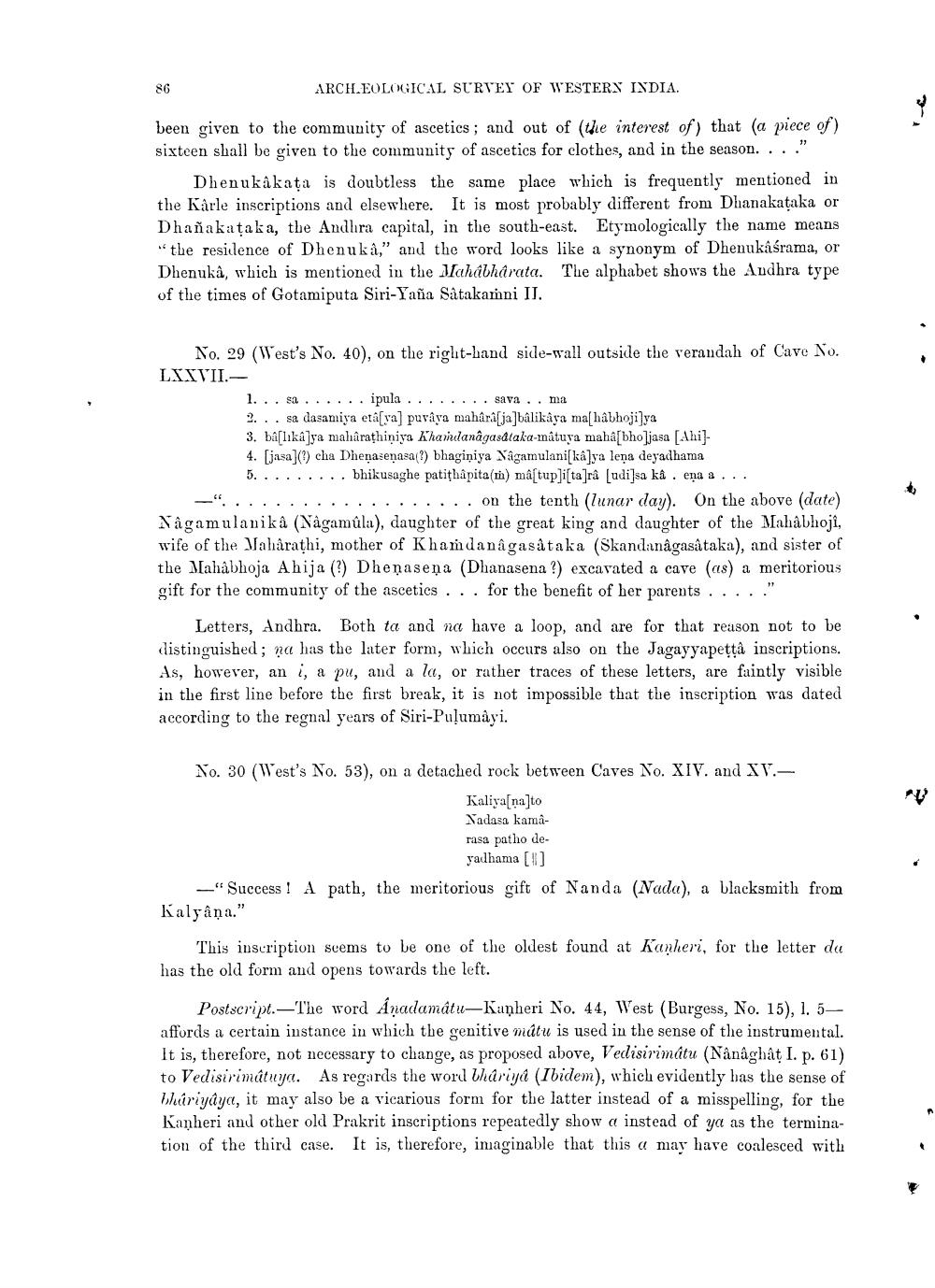________________
86
ARCH.EOLOGICAL SURVEY OF WESTERN INDIA.
been given to the community of ascetics; and out of the interest of that (a piece of) sixteen shall be given to the community of ascetics for clothes, and in the season. ..."
Dhenukakata is doubtless the same place which is frequently mentioned in the Kårle inscriptions and elsewhere. It is most probably different from Dhanakataka or Dhañakataka, the Andhra capital, in the south-east. Etymologically the name means "the residence of Dhenuka," and the word looks like a synonym of Dhenukaśrama, or Dhenuka, which is mentioned in the Mahabharata. The alphabet shows the Andhra type of the times of Gotamiputa Siri-Yaña Satakamni II.
No. 29 (West's No. 40), on the right-hand side-wall outside the verandah of Cave No. LXXVII. -
1... sa ...... ipula ........ sava .. ma 2. .. sa dasamiya etá[va) puvâya mahara[ja]balikâya mashabhoji]ya 3. ba[lika ya maharathiniya Khaanagasdlaka-matuya maha[bho]jasa [Ahi)4. (jasa) cha Dhenasenasa?) bhaginiya Nagamulani[kálya lena deyadhama 5. ........ bhikusaghe patithâpita(m) mástup]i[ta]rå (udi]sa kâ . ena a ...
...... on the tenth (lunar day). On the above (date) Nâgamulanikå (Någamůla), daughter of the great king and daughter of the Mahâbhoji, wife of the Jahârathi, mother of Khandanagasåtaka (Skandanagasåtaka), and sister of the Mahâbhoja Ahija (?) Dhenasena (Dhanasena?) excavated a cave (as) a meritorious gift for the community of the ascetics . . . for the benefit of her parents ....."
Letters, Andhra. Both ta and na have a loop, and are for that reason not to be distinguished; na has the later form, which occurs also on the Jagayyapetta inscriptions. As, however, ani, a pu, and a la, or rather traces of these letters, are faintly visible in the first line before the first break, it is not impossible that the inscription was dated according to the regnal years of Siri-Puļumáyi.
No. 30 (West's No. 53), on a detached rock between Caves No. XIV. and XV.
Kaliya[na]to Nadasa kama rasa patho de
yalhama [1] _"Success! A path, the meritorious gift of Nanda (Nada), a blacksmith from Kalyâņa."
This inscription seems to be one of the oldest found at Kanheri, for the letter da has the old form and opens towards the left.
Postscript. The word Anadamatu-Kaņheri No. 44, West (Burgess, No. 15), 1. 5affords a certain instance in which the genitive mátu is used in the sense of the instrumental. It is, therefore, not necessary to change, as proposed above, Vedisirimátu (Nânâghát I. p. 61) to Vedisirimátuya. As regards the word bhariya (Ibidem), which evidently has the sense of Whuriyâya, it may also be a vicarious form for the latter instead of a misspelling, for the Kanheri and other old Prakrit inscriptions repeatedly show a instead of ya as the termination of the third case. It is, therefore, imaginable that this a may have coalesced with




